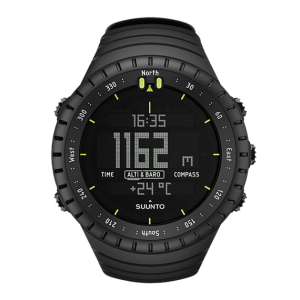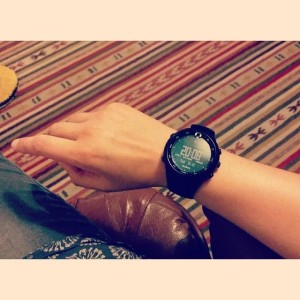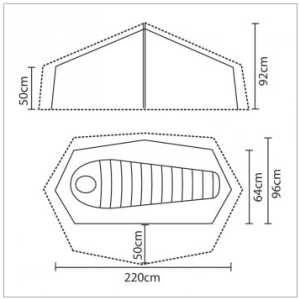I’ve written this blog post because… everyone else is doing it!

Osprey Exos 46 backpack.
Backpack:
I’m currently using an Osprey Exos 46 to carry my gear. The Exos has been updated this year and I picked up this, older version, in a sale. I actually prefer it as there’s plenty of room for all my gear and the newer version has a capacity of 48 litres rather than 46 and hence is heavier. The large number of outside pockets makes grabbing things on the run nice and easy. I keep my waterproofs, the tent, a drinks bottle, snacks, cash, and first kit all on the outside of my bag so that the gear I don’t use during the day is safely tucked away in a waterproof liner in the main compartment and doesn’t get disturbed.
It’s not the lightest backpack on the market (I have the “S” back size and it weighs just over 1Kg) but it does have a solid frame and is of the build quality you’d expect from a company like Osprey. Besides 1Kg is a very reasonable weight. (You’ll notice this is a running theme with my gear: not the lightest but still, reasonably light.) Osprey don’t make a women’s specific version of the Exos but I’ve found this unisex version very comfortable. Some people criticise Osprey for adding too many features which raise the weight unnecessarily. In the Exos I quite like the gimmicks. You can get a drinks bottle out of the side pocket and stow your trekking poles without stopping.
One thing I’ve noticed to be a particularly British trait is to keep the tent on the outside of the bag. This enables pitching in the rain before opening up your rucksack and packing everything away inside the tent on a rainy morning, minimising gear getting wet and/or dropped in mud. It’s a mystery why Brits in particular would be mindful of this. I keep the tent pegs in an outside pocket, the poles in the side pocket, and the tent itself attached to the bottom of the rucksack.
There’s one waterproof liner in the main compartment, a Exped 40L Folding Ultralite Drybag, and some smaller waterproof bags in the outside pockets.

Wild Country Zephyros 1 tent.
Tent:
*** This tent had a failure! Please read blog post Terra Nova Customer Service ***
I wrote about it in my last blog post and here it is again, the Wild Country Zephyros 1. I’ve done some research and can’t find a better deal on a reasonably light solo 3-season tent. I’d like to replace mine with the updated, lighter version but for now it does the trick. My set-up weighs about 1.5Kg including pegs, poles, and bag. (The new version is approx. 300g lighter.)
I don’t bother with a groundsheet. The tent was so cheap and the floor so tough I don’t worry about putting a hole in it, I can always patch it if I do.

Top Row: Toakes Ultralite Solid Fuel Ti Cook System (stove, mug, windshield (not shown), Thermarest NeoAir Xlite Women’s Mattress. Middle Row: Sawyer Mini Water Filter, Headphones, Titanium Folding Spork, 2 x 12″ Nite Ize Gear Ties, Swiss Army Knife, Petzl e+lite Headtorch. Bottom Row: Decathlon Inflatable Pillow, Platypus 500ml Water bottle.
Stove:
Experts say that there are 3 big items you should focus on to reduce the weight you’re carrying. Firstly the backpack itself, secondly the tent, and thirdly the stove. In this third category I’m doing pretty well. My favourite stove is a titanium solid fuel stove, a titanium mug, and a titanium windshield weighing in total about 100g. (Pictured above top left.) It’s made by Toakes and sold as the “Ultralite Solid Fuel Ti Cook System” and it comes with a titanium folding spork and some little bags to keep everything in. It’s only good when I’m solo backpacking due to the size of the mug/pot but it’s a lovely little set-up.

Mountain Equipment Xero 550 down sleeping bag, occupied.
Sleeping System:
Currently I’m using a Mountain Equipment Xero 550 down sleeping bag which weighs 1.04Kg on my scales. I really could do with a lighter one for the summer. Currently it’s used as a quilt in the warmer weather or paired with an Alpkit bivi bag for sub-zero temperatures.
A Thermarest NeoAir Xlite inflatable mattress (355g) and an inflatable pillow from Decathlon which was stupidly cheap and works really well (81g) finish off my sleep system and altogether they’re extremely comfortable.

Viewranger app with OS map and route tracking running on Samsung Galaxy Note 3.
Other Bits and Pieces:
Those are the key items but obviously there are lots of other things in my backpack. I mainly use Viewranger maps on a Samsung Galaxy Note 3 as a GPS. There’s an mp3 player and headphones to help me sleep if a campsite’s noisy. A spare water carrier (either a 1L or 2L Source collapsable water container), lighter, money, toiletries, etc.
In terms of clothes I take a lightweight Rab waterproof jacket and, if rain is forecast, waterproof trousers. In the summer months I wear a Tiley hat to keep the sun out of my eyes and the rain off my head. In the winter I’ll take a warm hat, gloves, buff, and merino thermal layers. Wet feet on a weekend in Norfolk taught me to always pack a dry pair of socks. Recently I’ve added a cheap pair of cotton shorts to the list to wear inside my tent when my walking trousers are particularly wet and muddy. I also have a Rab insulated down vest that packs down very small and is a real comfort on a chilly evening.

Well there you have it, my kit list. In total it weighs about 6Kg before I add water, food, and fuel for the stove. Definitely not ultra-lightweight but it is on the lighter end of the scale. I’m too fond of my comfort items (mp3 player, tent socks, pillow) to ever get down to ludicrously lightweight so I’m reasonably happy with my reasonably lightweight set-up.







































